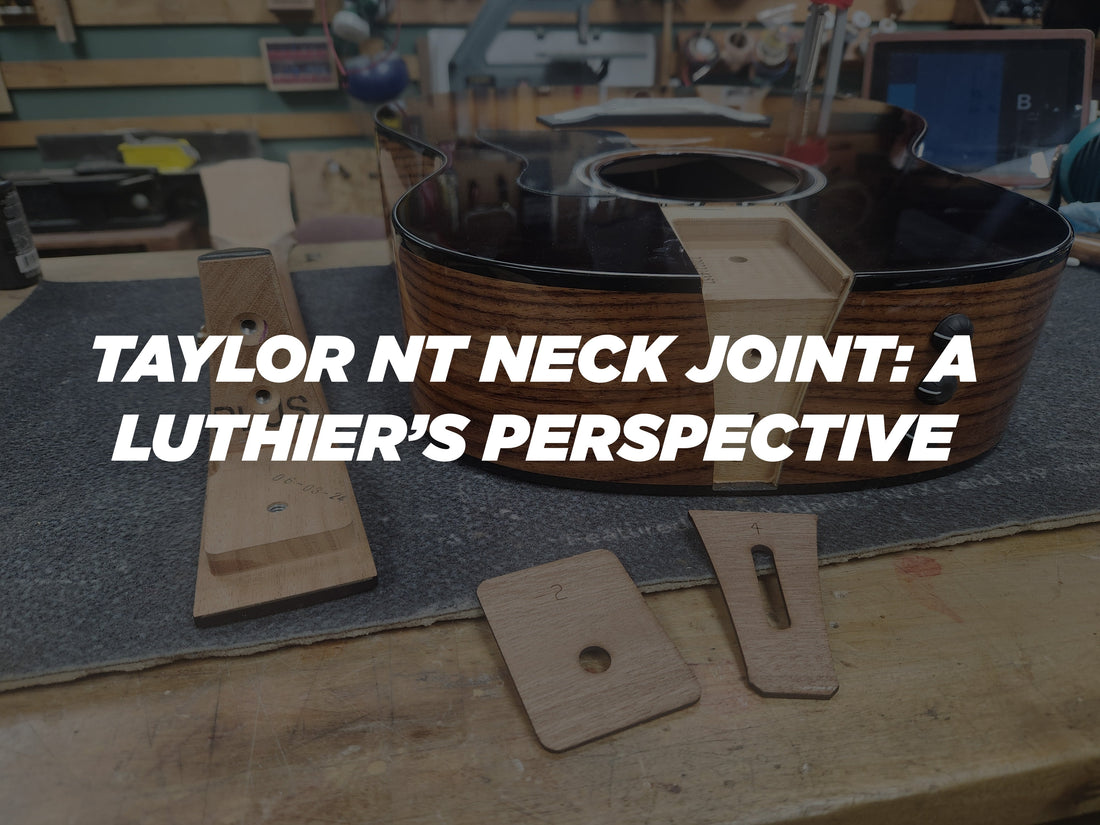
Taylor NT Neck Joint: A Luthier’s Perspective
Share
Resetting an acoustic guitar neck is one of the more involved and complicated repair procedures that a luthier might have to perform. It’s also something that every acoustic guitar will need done at some point in its lifetime; due to the distortion in body geometry that gradually occurs with 20+ years of a sustained 170ish lbs of string tension, the neck will gradually lean forwards, and the action will rise in excess of what can be corrected with simple saddle height adjustments. The proper way to correct this, is to remove the neck, and refit the neck joint so the neck meets the body at a steeper angle. The majority of acoustic guitars built within the past century utilize a dovetail joint to attach the neck, which can be difficult and risky to remove and reset. The procedure for removal involves pulling the fret over the dovetail joint (usually the 15th fret), and drilling a few holes through the fret slot and into the dovetail joint, through which steam can be injected into the joint, to gradually work it loose. I’ve done plenty of them, and while there’s something satisfying about the craftsmanship, it’s not exactly the most efficient repair on the menu, and the time and skill required to perform the job properly makes it a prohibitively costly procedure (upwards of $600).
Taylor’s NT (New Technology) neck joint takes a completely different approach, and from a repair perspective, it’s one of the best modern design decisions I’ve seen on an acoustic guitar.
The NT joint uses a bolt-on system with precision-cut shims to control the neck angle. There’s no glue involved, and the heel is completely flat, which means the neck can be removed and reinstalled without steam or heat. That alone saves hours of labor and completely eliminates the risk of steam damage to the finish or internal braces.

When one of these guitars comes in needing a reset—which they eventually will, like any acoustic—it’s not a guessing game. I know exactly what I’m dealing with before I even take the neck off. The shims Taylor uses are cut to exact tolerances, and I keep a large assortment on hand so I can easily reset the neck angle in under an hour. No need to chisel or sand the heel; just swap the shim, bolt it back together, and check the geometry. It’s efficient, it’s clean, and it’s completely reversible.
Some people will argue that the NT joint, or any bolt on neck joint, for that matter, is totally inferior to a dovetail, but this is simply false. Taylor’s build quality and neck-to-body fit are consistent enough that there’s no perceptible tonal downside, and the ability to reset the neck quickly, with minimal risk or cost, far outweighs any theoretical tonal difference.

From a service standpoint, this design is miles ahead of a glued dovetail. I don’t think it’s overstating things to say that the NT neck joint is one of the most luthier-friendly design innovations in modern acoustic guitar construction. It’s a great example of how thoughtful engineering can respect tradition while improving serviceability and consistency—something I think the industry could use more of. After nearly two decades of repairing instruments of all makes and vintages, I’ve developed a deep appreciation for designs that make long-term maintenance less invasive and more consistent. The NT joint is a great case study in how smart design choices can extend the useful life of an instrument while minimizing risk during service. It’s also influenced the way I approach my own builds—I’ve started incorporating more service-friendly construction elements, knowing first hand just how much of a difference that can make for the player, the tech, and the future longevity of the instrument.
